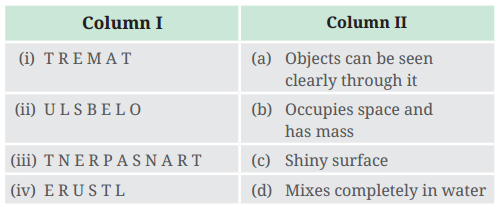Where Can I Find Materials Around Us Class 6 Questions And Answers For Better Exam Preparation?
FAQs on NCERT Solutions For Class 6 Science Chapter 6 Materials Around Us
1. What does Class 6 Science Chapter 6 "Materials Around Us" mainly teach about materials?
Class 6 Science Chapter 6 explains how different materials are used to make objects around us and how they are classified based on their properties such as appearance, texture, transparency, solubility, mass, and volume. These NCERT Solutions guide students to identify and categorize materials according to the CBSE 2025–26 syllabus.
2. How are materials classified in NCERT Solutions for Class 6 Science Chapter 6?
Materials are classified by their properties such as texture, hardness, transparency, solubility, lustre, and more. The solutions help students distinguish between transparent, translucent, and opaque materials, and between soluble and insoluble substances as per CBSE guidelines.
3. Why is transparency an important concept in sorting materials? (CBSE Methodology)
Transparency helps us determine how much light can pass through a material. NCERT Solutions show that understanding whether a material is transparent, translucent, or opaque is vital for choosing the right material for specific uses (e.g., glass for windows).
4. What is the difference between mass and volume as described in this chapter?
Mass is the amount of matter in an object, while volume is the amount of space it occupies. NCERT Solutions for Class 6 Science Chapter 6 guide students in measuring and understanding both properties, following the CBSE pattern.
5. How does the chapter explain solubility using daily examples?
Solubility is explained by observing what materials dissolve in water (like sugar or salt) and what does not (like sand or oil). The NCERT Solutions give real-life scenarios to help students link solubility concepts with everyday materials in their kitchen or home.
6. Why are objects made from different materials according to Chapter 6?
Objects are made from different materials because each material has unique properties that suit specific purposes. The solutions clarify how the choice of material depends on needs like strength, transparency, or durability, as guided by CBSE 2025–26 curriculum.
7. What stepwise approach does NCERT Solution recommend for solving classification questions in Chapter 6?
Follow these steps:
- Observe the object’s properties (appearance, hardness, texture, etc.)
- Match each property to classification groups in the NCERT table
- Use examples from textbook exercises for reference
- Justify your grouping with clear reasoning
8. How does Class 6 Science Chapter 6 NCERT Solution address misconceptions about materials?
The solutions clarify misconceptions, such as 'all shiny objects are metals' or 'glass is always opaque.' They correct such misunderstandings, stating that appearance and transparency must both be checked, following CBSE best practices for accuracy.
9. In what ways does Chapter 6 help you understand the historical use of materials?
It explores examples like clay, terracotta, and ancient pottery to illustrate how material use has evolved, showing the connection between material properties and their functional or cultural roles over time, as per curriculum emphasis on real-world relevance.
10. How can practice with NCERT Solutions for Chapter 6 improve a student’s scientific thinking?
Regular practice develops a habit of systematic classification, observation, and application of concepts. The solutions encourage students to draw logical conclusions from properties, which builds strong scientific reasoning and analytical skills according to CBSE standards.
11. What does 'matter' mean, as explained in the NCERT Solutions for Class 6 Science Chapter 6?
Matter is defined as anything that has mass and occupies space. The NCERT Solutions use easy-to-understand examples (like an apple or air) to illustrate this definition, in line with the Class 6 Science curriculum.
12. What are desirable properties of materials used to make chairs, as per NCERT Solutions?
Properties include:
- Hardness (strong and does not bend easily)
- Lightweight (for easy movement)
- Comfort (does not feel too cold or hot)
- Ease of cleaning (can be cleaned regularly)
13. How do NCERT Solutions for Chapter 6 address scenario-based application questions?
By presenting case studies and practical questions, the solutions require students to apply their learning to new situations (e.g., selecting a container for waste or organizing kitchen items), thus preparing them for advanced application-style questions in the CBSE exam.
14. What is the recommended method for correcting false statements about materials, as per the NCERT Solutions?
First, identify why the statement is incorrect, then write the corrected version using reasoning based on the material’s properties. Solutions encourage basing every correction on observations or textbook facts, matching CBSE’s answer-key standards.
15. Why is understanding solubility necessary for everyday problem-solving, as emphasized in Class 6 Science Solutions?
Knowing which materials are soluble or insoluble helps in daily life, such as choosing the right cleaning agents, food preparation, or separating mixtures. The NCERT Solutions make students aware of these applications to foster real-world problem-solving skills.


























